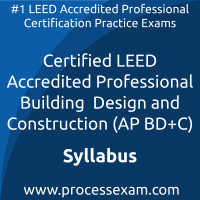 To achieve the professional designation of USGBC LEED Accredited Professional Building Design and Construction from the USGBC, candidates must clear the AP BD+C Exam with the minimum cut-off score. For those who wish to pass the USGBC LEED Accredited Professional Building Design and Construction certification exam with good percentage, please take a look at the following reference document detailing what should be included in USGBC LEED AP BD+C Exam preparation.
To achieve the professional designation of USGBC LEED Accredited Professional Building Design and Construction from the USGBC, candidates must clear the AP BD+C Exam with the minimum cut-off score. For those who wish to pass the USGBC LEED Accredited Professional Building Design and Construction certification exam with good percentage, please take a look at the following reference document detailing what should be included in USGBC LEED AP BD+C Exam preparation.
The USGBC AP BD+C Exam Summary, Sample Question Bank and Practice Exam provide the basis for the real Certified LEED Accredited Professional Building Design and Construction (AP BD+C) exam. We have designed these resources to help you get ready to take USGBC LEED Accredited Professional Building Design and Construction (AP BD+C) exam. If you have made the decision to become a certified professional, we suggest you take authorized training and prepare with our online premium USGBC LEED Accredited Professional Building Design and Construction Practice Exam to achieve the best result.
USGBC AP BD+C Exam Summary:
| Exam Name | USGBC LEED Accredited Professional Building Design and Construction |
| Exam Code | AP BD+C |
| Exam Fee |
Combined exam: $550 ($400 for USGBC members) Specialty only: $350 ($250 for USGBC members) |
| Exam Duration | 120 Minutes |
| Number of Questions | 100 |
| Passing Score | 170 out of 200 |
| Format | Multiple Choice Questions |
| Schedule Exam | USGBC |
| Sample Questions | USGBC LEED AP BD+C Exam Sample Questions and Answers |
| Practice Exam | Certified LEED Accredited Professional Building Design and Construction (AP BD+C) Practice Test |
USGBC LEED Accredited Professional Building Design and Construction Syllabus Topics:
| Topic | Details |
|---|---|
| LEED Process (8 Questions) |
- Different avenues to achieve LEED goals (e.g., developing credit interpretation rulings/requests; Regional Priority Credits; innovative credit submittals; use of pilot credits, etc.)
- LEED system synergies (e.g., energy and EQ; waste management) - Project boundary; LEED boundary; property boundary - Prerequisites and/or minimum program requirements for LEED certification - Knowing the evolutionary characteristics of LEED (e.g., development cycles of the rating systems; continuous improvement) |
| Integrative Strategies (9 Questions) |
- Integrative process (e.g., energy and water discovery items)
- Integrative project team, as applicable per project type and phase (e.g., architect; engineer; landscape artist; civil engineer; contractor; facility manager, etc.) - Value of collaboration (e.g., meeting on integrative green strategies) |
| Location and Transportation (9 Questions) |
- Site selection
- Access to quality transit: knowledge of access and quality concepts/calculations (e.g., accessibility to multimodal transportation choices; quality transit; bicycle network)
- Alternative transportation: infrastructure and design (e.g., parking capacity; bicycle storage and shower rooms; alternative-fuel fueling stations) - Green vehicles (e.g., fleet management; knowledge of regionalization of energy sources for electric power generation) |
| Sustainable Sites (9 Questions) |
- Site assessment (e.g., topography; hydrology; climate; vegetation; soils; human use; human health impacts)
- Site assessment: site as a resource (e.g., energy flows) - Construction activity pollution prevention (e.g., soil erosion, waterway sedimentation/contamination, airborne dust) - Site design and development
|
| Water Efficiency (9 Questions) |
- Outdoor water use reduction: irrigation demand (e.g., landscape water requirement; irrigation system efficiency; native and adaptive species)
- Indoor water use reduction
- Water performance management
|
| Energy and Atmosphere (14 Questions) |
- Building loads
- Energy efficiency
- Demand response (e.g., grid efficiency and reliability; demand response programs; load shifting)
- Alternative and renewable energy (e.g., on-site and off-site renewable energy; photovoltaic; solar thermal; wind; low-impact hydroelectricity; wave and tidal energy; green power, carbon offsets) - Energy performance management
- Environmental concerns: resource and ozone depletion (e.g., sources and energy resources [oil, coal and natural gas]; renewable and nonrenewable resources; chlorofluorocarbons [CFCs] and other refrigerants; stratospheric ozone layer)
- Energy model as a tool - Process loads (e.g., elevator; refrigeration, etc.) - Iterative optimization |
| Materials and Resources (12 Questions) |
- Reuse
- Life cycle impacts
- Waste
- Environmental concerns of materials (e.g., where materials came from; how they are used/exposures; where they might go/impacts)
|
| Indoor Environmental Quality (11 Questions) |
- Indoor environmental quality:
- Lighting: electric lighting quality (e.g., tradeoffs [color, efficiency]; surface reflectance; types of fixtures)
- Daylight (e.g., building massing and orientation; glare; human health impacts; illuminance) - Acoustic performance (e.g., exterior and interior noise; background noise; dead vs. live spaces) - Occupant comfort, health and satisfaction: controllability of systems (e.g., thermal; lighting) - Thermal comfort design (e.g., strategies to promote occupants’ productivity and comfort; values of occupant satisfaction) - Quality of views (e.g., connection to outdoor environment; direct line of sight to outdoors) |
| Project Surroundings and Public Outreach (4 Questions) |
- Regional design (e.g., regional green design and construction measures as appropriate)
- Cultural awareness; impacts and challenges; historic or heritage awareness - Educational outreach; public relations for the building |
Both USGBC and veterans who’ve earned multiple certifications maintain that the best preparation for a USGBC AP BD+C professional certification exam is practical experience, hands-on training and practice exam. This is the most effective way to gain in-depth understanding of USGBC LEED AP BD+C concepts. When you understand techniques, it helps you retain USGBC LEED Accredited Professional Building Design and Construction knowledge and recall that when needed.
